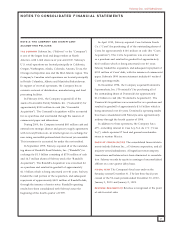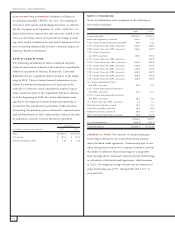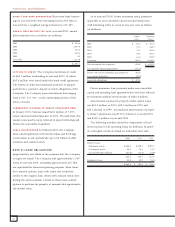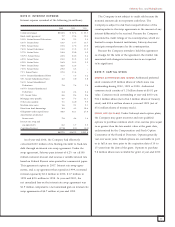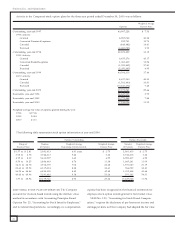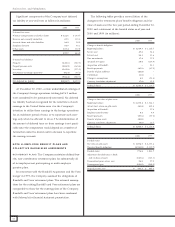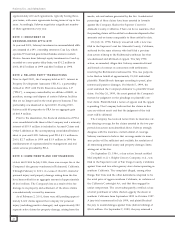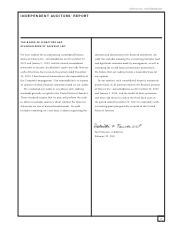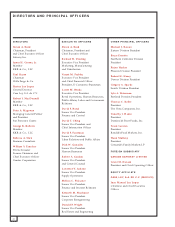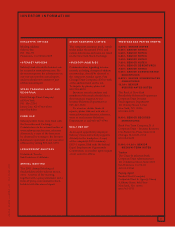Safeway 2000 Annual Report Download - page 41
Download and view the complete annual report
Please find page 41 of the 2000 Safeway annual report below. You can navigate through the pages in the report by either clicking on the pages listed below, or by using the keyword search tool below to find specific information within the annual report.
Safeway Inc. and Subsidiaries
39
The following table provides the components of 2000,
1999 and 1998 net pension income for the retirement plans
(in millions):
2000 1999 1998
Estimated return on assets $182.3 $ 162.7 $ 141.5
Service cost (47.7) (54.4) (52.5)
Interest cost (84.7) (81.6) (69.7)
Amortization of prior service cost (14.8) (15.4) (14.3)
Amortization of unrecognized gains 42.2 23.8 13.3
Net pension income $ 77.3 $ 35.1 $ 18.3
Prior service costs are amortized on a straight-line basis
over the average remaining service period of active partici-
pants. Actuarial gains and losses are amortized over the aver-
age remaining service life of active participants when the
accumulation of such gains and losses exceeds 10% of the
greater of the projected benefit obligation and the fair value
of plan assets.
In May 2000, Safeway entered into an agreement to have
a third party operate the Company’s Maryland distribution
center. Pursuant to the agreement, Safeway and the third
party jointly established a new multiple employer defined
benefit pension plan to provide benefits for the employees
that were transferred as a result of this agreement. The
Company recorded a $15 million settlement gain in 2000
as a result of transfers of accrued benefits and assets from
the Safeway Plan to the Multiple Employer Plan.
The actuarial assumptions used to determine year-end
plan status were as follows:
2000 1999 1998
Discount rate used to
determine the projected
benefit obligation:
United States Plans 7.8% 7.8% 6.5%
Canadian Plans 7.0 7.5 6.3
Combined weighted
average rate 7.6 7.7 6.5
Expected return on plan assets:
United States Plans 9.0% 9.0% 9.0%
Canadian Plans 8.0 8.0 8.0
Rate of compensation increase:
United States Plans 5.0% 5.0% 5.0%
Canadian Plans 5.0 5.0 4.5
RETIREMENT RESTORATION PLAN The Retirement
Restoration Plan provides death benefits and supplemental
income payments for senior executives after retirement.
The Company recognized expense of $4.7 million in 2000,
$5.4 million in 1999 and $5.0 million in 1998. The
aggregate projected benefit obligation of the Retirement
Restoration Plan was approximately $53.1 million at
year-end 2000 and $48.4 million at year-end 1999.
MULTI-EMPLOYER PENSION PLANS Safeway participates in
various multi-employer pension plans, covering virtually all
Company employees not covered under the Company’s
non-contributory pension plans, pursuant to agreements
between the Company and employee bargaining units
that are members of such plans. These plans are generally
defined benefit plans; however, in many cases, specific
benefit levels are not negotiated with or known by the
employer-contributors. Contributions of $154 million in
2000, $144 million in 1999 and $119 million in 1998
were made and charged to expense.
Under U.S. legislation regarding such pension plans, a
company is required to continue funding its proportionate
share of a plan’s unfunded vested benefits in the event of
withdrawal (as defined by the legislation) from a plan or
plan termination. Safeway participates in a number of these
pension plans, and the potential obligation as a participant
in these plans may be significant. The information required
to determine the total amount of this contingent obligation,
as well as the total amount of accumulated benefits and net
assets of such plans, is not readily available. During 1988
and 1987, the Company sold certain operations. In most
cases, the party acquiring the operation agreed to continue
making contributions to the plans. Safeway is relieved of the
obligations related to these sold operations to the extent that
the acquiring parties continue to make contributions.
Whether such sales could result in withdrawal under ERISA
and, if so, whether such withdrawals could result in liability
to the Company, is not determinable at this time.
COLLECTIVE BARGAINING AGREEMENTS At year-end
2000, Safeway had approximately 192,000 full and part-
time employees. Approximately 78% of Safeway’s employees
in the United States and Canada are covered by collective
bargaining agreements negotiated with local unions affiliat-
ed with one of 12 different international unions. There are


